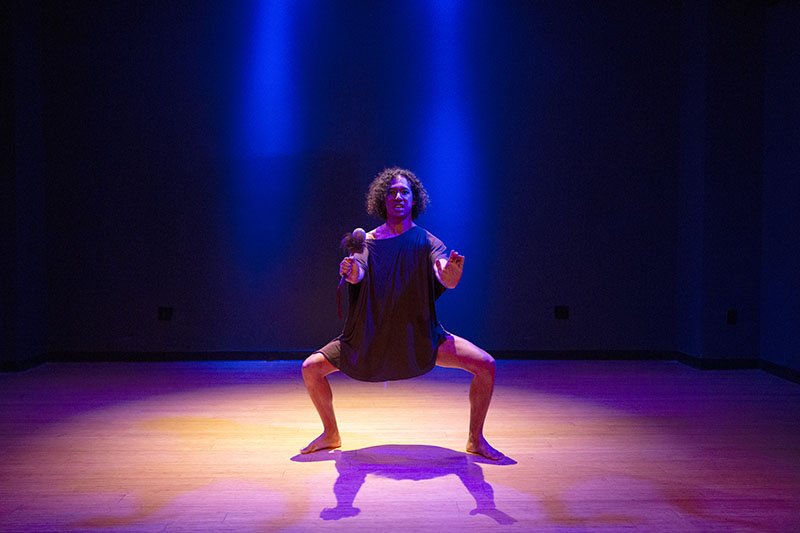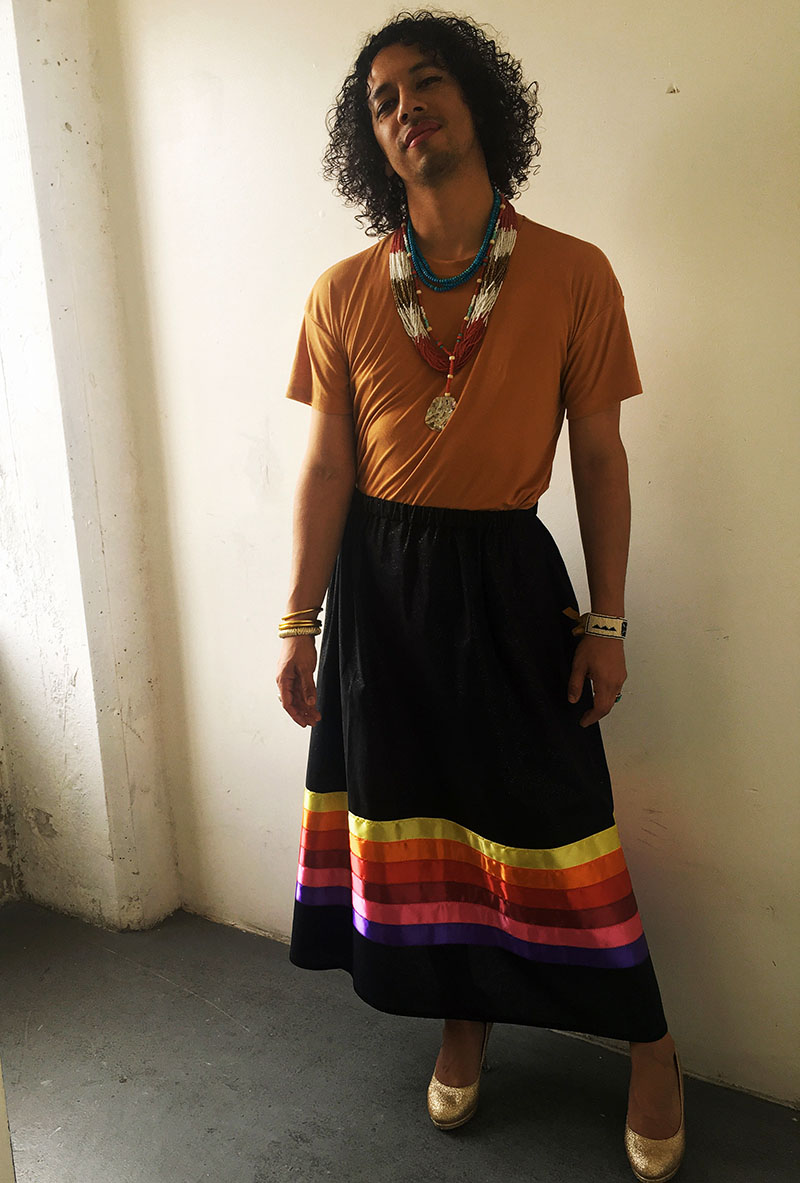“Making It” As An Indigenous Two-Spirit Dancer
Editorial Note: For the past eight years, Stance on Dance has asked a variety of dance artists at different points in their careers what “making it” means to them. Please join us in looking at what “making it” means as a dancer, artist and human.
BY SNOWFLAKE CALVERT (DANIEL ARIZMENDI)
My dream as an aspiring teenage dancer was about being hired into a ballet company and working my way up the ranks. I wanted to work professionally with as many companies and choreographers as I could and be taught by top teachers from around the world. My hope was to perform as much as possible in leading ballet roles while exploring multiple dance styles. Owning my own dance studio to create a platform for other dancers was also a desire of mine for many years. The ambitions I had drove me to pursue my dreams sometimes to exhaustion. Due to misinformation, I thought that dancers couldn’t find work past the age of 35; as a result, I’m humbled to say I was able to do all those things by the time I was 30. So then, I wondered: what does “making it” look like now? Is it a series of checkpoints? What does “making it” look like for a decolonizing Indigenous Two-Spirit in the United States?
I am an Indigenous Two-Spirit (Yaqui and Mayan) American born in Rumsen Ohlone territory in Salinas, California. My Mayan father was born and raised in Chiapas, Mexico in the Lacandon Jungle. My father’s family immigrated to the US when my dad was 15 years old, barefoot and wearing American clothing they found in a dumpster. Without a formal western education, my family had few options but to work in produce fields and canneries. They made pennies working for companies that to this day still exploit immigrant labor. After three years of two parents and nine children living out of a car, they finally could afford not to be homeless. My father discovered his passion for martial arts, and it became a vehicle for my family to become self-sufficient.
My mother, of Yaqui and Raramuri descent, was born into extreme poverty because Native Americans had few work options outside of the reservation. Like many Yaquis, my grandpa was able to find consistent work building railroad tracks. My grandmother was a housewife and also worked in the orchards. During my mom’s childhood, they lived in a shack with dirt floors and holes in the roof. As adults, my parents overworked themselves to become entrepreneurs and sustain day jobs while raising a family. Out of all our relatives, they were the lucky ones who pulled themselves out of poverty. When I made the decision to dance professionally as a teenager, my family had a lot of doubt and concern. I was the only dancer in the family at that time. No one really understood what being a dancer in America could be. I worked hard to prove to them that my dream was something worth investing in. I’m proud to say that I “made it” by showing them the possibilities and opportunities that dance can bring to people.

Photo by Lydia Daniller
To be an American artist and have a stable income is a privilege that I never take for granted. This is a “making it” checkpoint for me. I’ve been able to travel the world, meet some of the most amazing people, teach at the university level, and use my art to help strengthen LGBTQ+ communities. And now my family has other dancers who are pursuing their own dreams in the dance world.
Recently, I’ve learned more about my people’s history as survivors of systematic genocide. The first people who the Spaniards murdered among my ancestors were the artists, dancers, singers, musicians, writers, and healers. Each one of those occupations was complementary to each other, as they were integral parts to Mayan culture and spirituality. These sacred societal roles held offices of great influence and passed down our history for thousands of years.
Indigenous performance isn’t just for entertainment. It is a sacred ritual ceremony to give those in attendance time to receive visual medicine. People learned history, life lessons, and prayer through performances engaged in ceremony. Artists carried the responsibility of continuing our living history as my people advanced in science, astronomy, and math. My ancestors’ artistry shattered the illusions of the Spanish colonial mindset, and they were murdered for it.
Fast forward 518 years to the present day: my people and I have survived. We didn’t suddenly disappear for some unknown reason like many have said. The Maya peoples are still living on our ancestral lands, and have an autonomous region in Chiapas. We continue to speak our unique language with over 30 dialects, and many are still living in the traditional way of our ancient culture. We survived a Spanish genocide that lasted hundreds of years. While there was so much that was taken from us over the centuries, we are still fighting hard against colonialism and erasure culture. My people never stopped dancing.
I want to use my art to contribute to the healing, revitalization, and cultural restoration of my tribes and peoples. I push myself to be radical in decolonizing my body in the hope that future generations of Indigenous dancers will have more visibility. My hope is also for non-indigenous people who have lost their ancestral connection and culture to benefit from this medicine. I use my platform to help people in various ways: free healing clinics, Indigenous talking circles and panels, free food events, advancing other artists, making space for QTPOC/QPOC voices to be heard, and positive dialogue for strengthening Black and Native relations in the US.
As a classically trained ballet dancer, the ability to push the boundaries of European dance theatre while exploring Indigenous forms of ritual performance has had a profound impact on me. I used to begin teaching choreography as quickly as I could in order to have a finished product within an allotted time frame. There was little room to interact with the dancers beyond relaying information about the dance piece. Now, with a stronger Indigenous mindset, I see the process of creating art as an opportunity to honor each individual’s ancestral bloodline, seeing each dancer as a part of their family’s legacy. This leaves room for ancestral, personal, and collective culture to be intentionally free flowing. When I can facilitate this self-explorative environment, I feel I reach another “making it” checkpoint. It is healing to be seen and heard on a cultural level. True magic is in the creation process, and the performance allows audience members to participate in the culmination of that collective collaboration.
My next “making it” checkpoint is the goal of contributing to my tribes and cultures in hopes of creating better visibility and content for future generations of Yaqui and Mayan Two-Spirit people. My dream is for seven generations in the future to benefit from learning from my mistakes and successes. I want to be one of many whose content gets archived for future Two-Spirits to build from. There aren’t a lot of records of Two-Spirit people from previous generations due to colonial homophobia, so creating content for future generations is very important to me. If I’m going to leave one message for every future Two-Spirit, it should read:
“Auntie Snowflake loves you and is thinking of you. You and your artistry are the default culture here on Turtle Island. It’s colonialism that’s out of context, not you. [Lios emchin aniabo.] Learn to heal from the bad experiences and be proud of the good times. Regardless of money, an audience, or a proper stage, continue to dance for yourself. Give yourself permission to enjoy the journey of getting to your career checkpoints, and always dance your truth.”

Photo by Ben Arizmendi-Calvert
~~
Snowflake Calvert (Daniel Arizmendi) is a Two-Spirit artist of Yaqui and Tzotzil Mayan heritage, who serves as the President of QUIL (Queers United for Intersectional Liberation). She produces queer events throughout California and Oregon that allow her to curate a vehicle for political, social, and cultural activism through the artistry of her radical queerness. In addition, she is a professional dancer, teacher and entrepreneur. She was a member of The Haus of Towers, has worked with the BAAITS Powwow committee, teaches decolonization through movement workshops, is the former owner/director of The Dance Zone Studio, and hosts and participates in two-spirit talking circles.
Follow Snowflake on Instagram @arizmendi or on Facebook by searching for Snowflake Calvert.

One Response to ““Making It” As An Indigenous Two-Spirit Dancer”
fabulous!
Comments are closed.